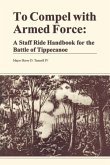This study investigates the Tippecanoe campaign and battle conducted in 1811 between the United States military forces under the command of General William Henry Harrison and an Indian confederacy based at Tippecanoe. The study identifies and describes important relationships and treaties between the United States and Indians in the American northwest during the late eighteenth - and early nineteenth - century. The study details the actions in Harrison's Tippecanoe campaign in the fall of 1811. United States and woodland Indian military doctrine, tactics, and organization that apply to Tippecanoe are described. The study also describes key battlefield activities of the Tippecanoe battle on 7 November 1811. This work has been selected by scholars as being culturally important, and is part of the knowledge base of civilization as we know it. This work was reproduced from the original artifact, and remains as true to the original work as possible. Therefore, you will see the original copyright references, library stamps (as most of these works have been housed in our most important libraries around the world), and other notations in the work. This work is in the public domain in the United States of America, and possibly other nations. Within the United States, you may freely copy and distribute this work, as no entity (individual or corporate) has a copyright on the body of the work. As a reproduction of a historical artifact, this work may contain missing or blurred pages, poor pictures, errant marks, etc. Scholars believe, and we concur, that this work is important enough to be preserved, reproduced, and made generally available to the public. We appreciate your support of the preservation process, and thank you for being an important part of keeping this knowledge alive and relevant.
Bitte wählen Sie Ihr Anliegen aus.
Rechnungen
Retourenschein anfordern
Bestellstatus
Storno









